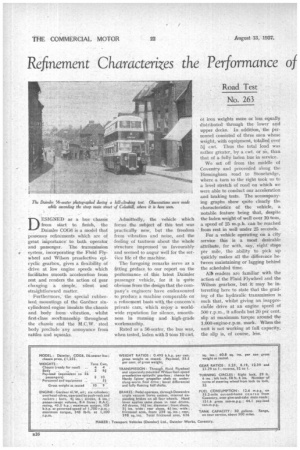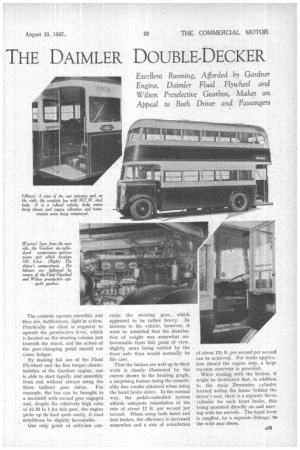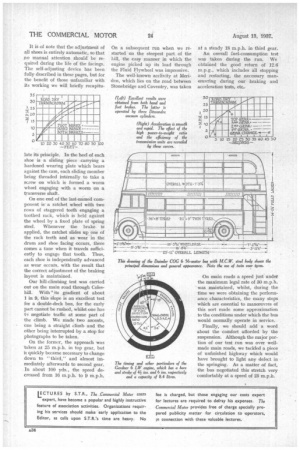Refinement Characterizes the Performance of
Page 50

Page 51

Page 52

If you've noticed an error in this article please click here to report it so we can fix it.
THE DAIMLER DOUBLE-DECKER
Excellent Running, Afforded by Gardner Engine, Daimler Fluid Flywheel and Wilson Preselective Gearbox, Makes an Appeal to Both Driver and Passengers DESIGNED as a bus chassis from start to finish, the Daimler COG6 is a model that possesses refinements which are of great importance to both operator and passenger. The transmission system, incorporating the Fluid Flywheel and Wilson preselective epicyclic gearbox, gives a flexibility of drive at low engine speeds which facilitates smooth acceleration from rest, and renders the action of gear changing "a simple, silent and straightforward matter.
Furthermore, the special rubberized mountings of the Gardner sixcylindered engine insulate the chassis and body from vibration, whilst first-class .workmanship throughout the chassis and the M.C.W. steel body preclude any annoyance from rattles and squeaks. Admittedly. the vehicle which forms the subject of this test was practically new, but the freedom from vibration and noise, and the feeling of tautness about the whole structure impressed us favourably and seemed to augur well for the seri7ice life of the machine.
The foregoing remarks serve as a fitting preface to our report on the performance of this latest Daimler passenger vehicle, for it is quite obvious from the design that the company's engineers have endeavoured to produce a machine comparable on a refinement basis witiLthe concern's private cars, which enjoy a worldwide reputation for silence, smoothness in running and high-grade workmanship Rated as a 56-seater, the bus was, when tested, laden with 3 tons 10 cwt.
of iron weights more or less equally distributed through the lower and upper decks. In addition, the personnel consisted of three men whose weight, with equipment, totalled over 51 cwt. Thus the total load was rather greater, by a cwt. or so, than that of a fully laden bus in service.
We set off from the middle of Coventry and proceeded along the Birmingham road to Stonebridge, where a turn to the right took us to a level stretch of road on which we were able to conduct our acceleration and braking tests. The accompanying graphs show quite clearly the characteristics of the vehicle, a notable feature being that, despite the laden weight of well over 10 tons, a speed of 25 m.p.h. can be reached horn rest in well under 25 seconds.
For a vehicle operating on a city service this is a most desirable attribute, for with, say; eight stops per mile, the ability •to pick up quickly makes all the difference between maintaining or lagging behind the scheduled time.
AIN readers are familiar with the action of the Fluid Flywheel and the Wilson gearbox, but it may be interesting here to state that the grading of the hydraulic transmission is such that, whilst giving an inappreciaBle drive at an engine speed of 500 r.p.m., it affords but 20 per cent. slip at maximum torque around the 1,000 engine-r.p.m. mark. When the unit is not working at full capacity, the slip is, of course, less. The controls operate smoothly and they are, furthermore, light in action. Practically no effort is required to operate the preselective lever, which is located on the steering column just beneath the wheel, and the action of the gear-changing pedal should not cause fatigue.
By Making full use of the Fluid Flywheel and the fine torque characteristics of the Gardner engine, one is able to start rapidly and smoothly from rest without always using the three indirect gear ratios. For example, the bus can be brought to a standstill with second gear engaged and, despite the relatively high ratio of 12.39 to 1 for this gear, the engine picks up its load quite easily, if road conditions be slightly favourable.
Our only point of criticism con
cerns the steering gear, which appeared to be rather heavy. In fairness to the vehicle, however, it must be admitted that the distribution of weight was somewhat unfavourable from this point of view, slightly more being carried by the front axle than would normally be the case.
That the brakes are well up to their work is clearly illustrated by the curves shown in the braking graph, a surprising feature being the remarkably fine results obtained when using the hand brake alone. In the normal way, the pedal-controlled system affords adequate retardation at the rate of about 12 ft. per second per second. When using both hand and foot brakes, the efficiency is increased somewhat and a rate of retardation of about 13i ft. per second per second can be achieved. For brake application should the engine stop, a large vacuum, reservoir is provided.
While dealing with the brakes, it might be mentioned that, in addition to the main Dewandre cylinder located within the frame behind the driver's seat, there is a separate Servo cylinder for each front brake, this being mounted directly on and moving with the swivels. The hand lever is coupled, by a separate linkage, to the wide rear shoes. It is of note that the adjustment of all shoes is entirely automatic, so that no manual attention should be required during the life of the facings. The self-adjusting device has been fully described in these pages, but for the benefit of those unfamiliar with its working we will briefly recapitu late its principle. In the heel of each shoe is a sliding piece carrying a hardened wearing plate which bears against the cam, each sliding member being threaded internally to take a screw on which is formed a worm wheel engaging with a worm on a transverse shaft.
On one end of the last-named component isa ratchet wheel with two rows of staggered teeth engaging a toothed rack, which is held against the wheel by a fixed plate of spring steel. Whenever the brake is applied, the ratchet slides up one of the rack teeth and as wear in the drum and shoe facing occurs, there comes a time when it travels sufficiently to engage that tooth. Thus, each shoe is independently advanced as wear occurs, with the result that the correct adjustment of the braking layout is maintained.
Our hill-climbing test was carried out on the main road through Coleshill. With *its gradient of about I in 9, this slope is an excellent test for a double-deck bus, for the early part cannot be rushed, whilst one has t.) negotiate traffic at some part of the climb. We made two ascents, one being a straight climb and the other being interrupted by a stop for photographs to be taken.
On the former, the approach was 'taken at 23 m.p.h. in top gear, but it quickly became necessary to change down to "third,' and almost immediately afterwards to second gear. In about 100 yds., the speed decreased from 16 m.p.h. to 9 m.p.h. On a subsequent run when we restarted on the steepest part of the hill, the easy manner in which the engine picked up its load through the Fluid Flywheel was impressive.
The well-known acclivity at Meriden, which lies on the road between Stonebridge and Coventry, was taken at a steady 18 m.p.h. in third gear.
An overall fuel-consumption test was taken during the run, We obtained the good return of 12.6 m.p.g., which includes all stopping and restarting, the necessary manoeuvring during our braking and acceleration tests, etc.
On main roads a speed just under the maximum legal rate of 30 m.p.h. was maintained, whilst, during the time we were obtaining the perform:ance characteristics, the many stops which are essential to manoeuvres of this sort made some approximation to the conditions under which the bus would normally operate in service.
Finally, we should add a word about the comfort afforded by the suspension. Although the major portion of our test run was over wellmade main roads, we tackled a piece of unfinished highway which would have brought to light any defect in the springing. As a matter of fact, the bus negotiated this stretch very comfortably at a speed of 25 m.p.h.




















































































